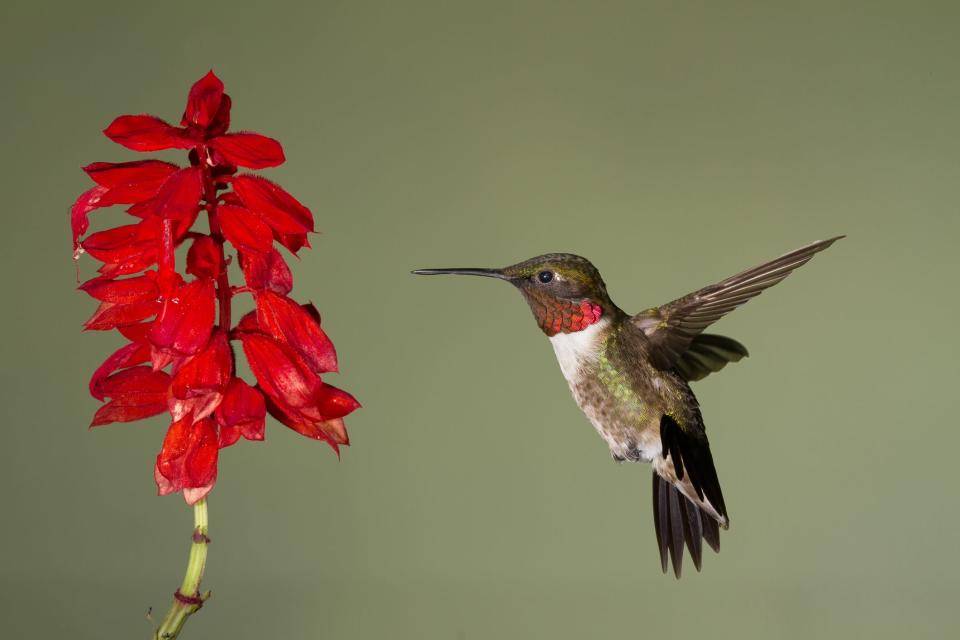Plant these red, nectar-rich flowers to attract hummingbirds | Sally Scalera
This spring the native Coralbean, Erythrina herbacea, in our Brevard Discovery Garden received numerous visits from hummingbirds. I know this because the tree is full of seed pods, which are only produced when the flowers are pollinated by a hummingbird. Even if you miss the hummingbird when it visits, the seed pods will prove they are nearby.
I have often been asked if we really have hummingbirds here in Brevard County, and my answer is always yes, we do.
The main way to attract hummingbirds to your yard is to plant numerous plants that produce nectar-rich red flowers. To be able to sit back and watch them, you will want to plant these plants near your house or around your outdoor sitting areas. The great thing about planting a coralbean in your yard is that it will let you know how many times a hummingbird has visited your tree.
It's hummingbird season in Florida: Here are 7 things to know about these amazing birds
Here are some interesting facts about hummingbirds:
They only live in the Americas.
338 species are known, 16 are in the United States, and three are in Florida. The black-chinned and rufous are winter visitors. The ruby-throated is the most common one in Florida and the only one that nests here.
The nest is walnut-size and adorned with lichens and moss, and is bound by spider webs or plant fibers.
Nesting begins in April.
Hummingbirds have one of the largest appetites in the bird world. They feed every 10-15 minutes from dawn to dusk.
The ideal flower colors for attracting hummingbirds are red, orange or pink.
They start eating as early as 45 minutes before sunrise, and really need energy after a cold night.
They also need protein and other nutrients, so they also eat soft-bodied insects, including mosquitoes and spiders.
Try setting out some overripe fruit (like banana peels) to attract flies for them to munch on.

If you don’t believe there are hummingbirds where you live, plant a coralbean tree and test that theory. Add salvias around the coralbean tree, because hummingbirds are from South America and have evolved with salvia plants with gorgeous, long tubular flowers full of nectar.
More: Spring has sprung! Here's what to do in your Brevard garden in April | Sally Scalera
More: These flowers bring all the bees to the yard | Sally Scalera
In addition to our native salvias, lyre-leaf sage (Salvia lyrata), and tropical red sage (Salvia coccinea), you could add our native cardinal flower (Lobelia cardinalis), beardtongue (Penstemon multiflorus), blue curls (Trichostema dichotomum) or butterfly milkweed (Asclepias tuberosa) to your yard.
For some non-native choices, there is the cigar flower (Cuphea ignata), shrimp plant (Justicia brandegeeana) and aloe (Aloe spp.).
If your landscape has room for a second tree, there is also our native geiger tree (Cordia sebestena) or the non-native red bottlebrush (Callistemon citrinus).
If you are interested in planting some new shrubs consider our native firebush (Hamelia patens), Florida pinxter azalea (Rhododendron canescens), scarlet hibiscus (Hibiscus coccineus) or the swamp hibiscus (H. grandiflorus).
If you are thinking of adding some vines to your landscape, why not plant some that the hummingbirds will enjoy? Those include the native coral honeysuckle (Lonicera sempervirens), cross vine (Bignonia capreolata) or trumpet creeper (Campsis radicans).
Hummingbird feeders need to be tended to often, so if you'd rather skip that chore, consider planting baby sunrose, Aptenia cordifolia, in a hanging basket. This gorgeous succulent plant produces red flowers that will attract hummingbirds. Just be sure to hang it near a window so you can watch the hummingbirds up close.
Before you plant your new hummingbird attracters, scatter some earthworm castings, and granular mycorrhizal mix in the planting hole. Make sure to keep an eye on your new plant and water them every few days if they are woody or daily if they are herbaceous.
After the plants are established and produce new foliage, inoculate them with a liquid product (i.e., Bushdoctor Kangaroots or Microbe Brew, etc.) that contains beneficial bacteria and mycorrhizae. A liquid product is mixed in water and used to water the plants. This could be repeated a second time.
If you would like to learn how to get the biology around the roots of the plants throughout your yard, email the UF/IFAS Extension Brevard County Master Gardeners at brevard-mg1@ifas.ufl.edu for more information.
Attracting hummingbirds is as easy as adding new plants to your yard. Remember though, to be able to catch a glimpse of them during their visits, make sure to plant their food source near your home. Yes, it’s that easy.
Suzy Fleming Leonard is a features journalist with more than three decades of experience. Reach her at sleonard@floridatoday.com. Find her on Facebook: @SuzyFlemingLeonard or on Instagram: @SuzyLeonard.
This article originally appeared on Florida Today: Florida has 3 species of hummingbirds; ruby-throated is most common

